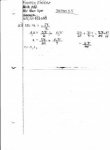I'm working on the following problem:
cos4x = -√3/2
but I don't see why the book listed the following solutions.
{5π/24, 7π/24, 17π/24, 19π/24, 29π/24, 31π/24, 41π/24, 43π/24}
When I change n to 1 I get 11pi/24. I'm completely stuck with this problem. Perhaps I'm not understanding the concept?
cos4x = -√3/2
but I don't see why the book listed the following solutions.
{5π/24, 7π/24, 17π/24, 19π/24, 29π/24, 31π/24, 41π/24, 43π/24}
When I change n to 1 I get 11pi/24. I'm completely stuck with this problem. Perhaps I'm not understanding the concept?

